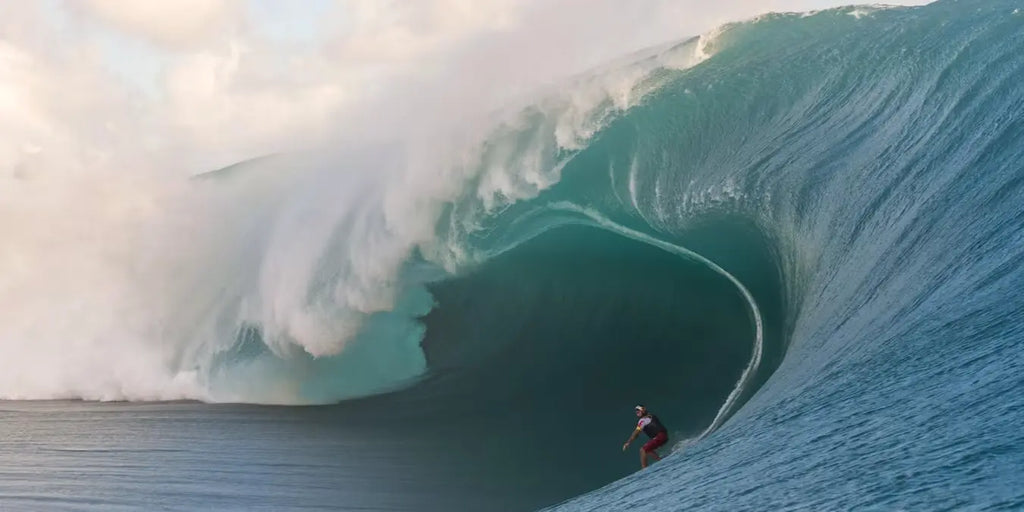6 faits surprenants sur le surf aux Jeux olympiques de Paris 2024

Introduction
Quand on pense aux Jeux olympiques de Paris 2024, on pense sans doute à la Tour Eiffel et aux paysages urbains animés de la France. Mais la compétition de surf se déroulera loin de la métropole, à plus de 15 000 kilomètres de là, à Tahiti . Connue pour ses eaux cristallines et ses vagues parmi les plus dangereuses de la planète, Teahupo'o s'annonce comme un lieu incontournable pour l'histoire du surf olympique.
Ce choix est plus qu'un simple paysage : c'est une décision audacieuse, motivée par la géographie, la science des vagues et un lien profond avec la culture du surf. Mais le rôle olympique de Tahiti n'est pas sans controverse. De la réputation meurtrière de la vague au passé colonial de l'île, l'événement de surf de 2024 promet d'être inoubliable, pour le meilleur et pour le pire.
Plongeons dans les faits fascinants sur le surf aux Jeux olympiques de Paris 2024, en commençant par la façon dont le surf a obtenu sa place olympique et pourquoi Tahiti a été choisie comme arène ultime.
1. De Tokyo à Tahiti : pourquoi la scène olympique de surf s'est déplacée à travers le monde
Le surf a fait ses débuts olympiques aux Jeux de Tokyo 2020 (organisés en 2021 en raison de la pandémie). L'épreuve s'est déroulée sur la plage de Tsurigasaki , un spot de surf populaire à environ 96 kilomètres de Tokyo. Si les vagues étaient correctes, elles manquaient de la grandeur attendue sur une scène internationale mettant en vedette les meilleurs surfeurs du monde.
Pour Paris 2024, les organisateurs ont misé sur un lieu capable d'offrir la puissance brute et les conditions exceptionnelles que ce sport mérite. Découvrez Teahupo'o, à Tahiti , un spot de surf légendaire souvent décrit comme l'une des vagues les plus dangereuses au monde .
Mais pourquoi Tahiti et pourquoi pas la côte française métropolitaine ? La réponse réside dans le timing et la nature. L' été dans l'hémisphère nord (lors des Jeux olympiques) n'est pas la saison idéale pour les grosses vagues en France métropolitaine. En revanche, la saison des vagues à Tahiti culmine entre avril et octobre , ce qui en fait l'endroit idéal pour des houles puissantes et constantes.
Au-delà d'un timing parfait, la géographie unique des fonds marins de Teahupo'o crée des vagues uniques au monde. Le fond marin s'élève brusquement des eaux profondes jusqu'à un récif corallien peu profond, provoquant des vagues rapides qui forment d'imposants tubes vitreux.
Ce passage du Japon à Tahiti représente non seulement un changement de décor mais aussi un changement d’état d’esprit : un engagement à présenter le surf dans sa forme la plus exigeante et la plus authentique .
2. Teahupo'o : la science derrière la vague la plus dangereuse du monde
La vague de Teahupo'o à Tahiti n'est pas seulement célèbre, elle est tristement célèbre . Connue pour ses tubes vitreux et imposants et son immense puissance, cette vague est considérée comme l'un des spots de surf les plus dangereux de la planète . Mais qu'est-ce qui la rend si unique et intimidante ?
Tout est une question de géographie et d'hydrodynamique . Dans la plupart des endroits, le fond océanique s'élève progressivement à mesure que les vagues s'approchent du rivage, ce qui permet à la houle de ralentir et de perdre de sa force. À Teahupo'o, en revanche, le fond océanique s'élève brusquement , passant de plus de 1 500 mètres de profondeur à quelques centaines de mètres seulement en quelques kilomètres.
Cette montée abrupte crée un effet de rampe , forçant la houle à monter au lieu de disperser son énergie. Le résultat ? Un mur d'eau presque vertical et vitreux qui se courbe en un tonneau parfait : le rêve du surfeur, mais aussi un cauchemar si les choses tournent mal .
Mais ce n'est pas seulement la hauteur de la vague qui est intimidante, c'est aussi la masse d'eau qui s'abat sur elle. Une seule section de la lèvre peut peser jusqu'à 4 000 kilos . Ajoutez à cela le récif corallien d'une netteté remarquable, situé à quelques mètres seulement sous la surface, et chaque descente à Teahupo'o devient un pari de vie ou de mort.
Les surfeurs qui bravent ces eaux doivent compter sur leur précision, leur courage et un profond respect pour la puissance de l'océan . Et lors des Jeux olympiques de Paris 2024, le monde entier pourra voir des athlètes s'attaquer à cette merveille naturelle sous la pression intense d'une compétition mondiale.
Ce n’est pas seulement un événement de surf, c’est une confrontation impressionnante entre les compétences humaines et la puissance brute de la nature .
3. Une photo virale qui a tout changé

En 2000 , une seule photographie a propulsé Teahupo'o au rang de célébrité mondiale. On y voyait le surfeur légendaire Laird Hamilton sur ce que beaucoup considèrent comme la vague la plus parfaite jamais surfée .
Capture d'une clarté cristalline, la photo montre Hamilton suspendu au milieu d'un tonneau, un imposant mur d'eau s'abattant sur lui, quelques instants avant qu'il ne s'écrase. L'image a fait la couverture du magazine Surfer et est instantanément devenue virale dans la communauté du surf .
Mais ce n'était pas seulement la taille de la vague qui stupéfiait les gens, c'était le danger qu'elle représentait . Le poids de l'eau, combiné au récif acéré en contrebas, traçait un tableau clair : Teahupo'o n'est pas qu'une vague, c'est une force de la nature .
Cette photographie n'a pas seulement fait connaître Hamilton. Elle a également suscité un pèlerinage de surfeurs professionnels à Tahiti, tous désireux de tester leurs compétences sur cette vague mythique.
Depuis, Teahupo'o est devenue un véritable terrain d'essai pour les surfeurs de grosses vagues , accueillant des compétitions annuelles et attirant des amateurs de sensations fortes du monde entier. Mais la vague n'a pas été clémente : des dizaines de surfeurs ont été grièvement blessés et au moins cinq ont perdu la vie en tentant de dompter cette bête aquatique.
Aux Jeux olympiques de Paris 2024, les meilleurs surfeurs du monde s'aligneront à Teahupo'o, espérant entrer dans l'histoire sur la même vague qui a changé le surf à jamais.
4. Surfer sur le rêve olympique : le défi de concourir à Teahupo'o
Surfer à Teahupo'o n'est pas seulement une question de technique, c'est aussi une question de survie . Les rouleaux imposants et le récif corallien acéré exigent non seulement des prouesses techniques, mais aussi des nerfs d'acier. Les athlètes qui participeront aux Jeux olympiques de Paris 2024 ne se contenteront pas de s'affronter entre eux ; ils affronteront l'une des forces les plus redoutables de la nature .
L'un des principaux défis du surf dans un tel environnement réside dans l' imprévisibilité de l'océan . Contrairement aux sports de stade, les compétitions de surf dépendent entièrement des conditions de vagues , et celles de Teahupo'o sont aussi imprévisibles que puissantes. Une vague parfaite peut déferler d'un seul coup, suivie d'un calme inquiétant l'instant d'après.
Le timing est primordial. Les surfeurs doivent analyser l'océan, anticiper la houle et s'engager pleinement sur chaque vague. L'hésitation n'est pas de mise : une fois plongé dans la vague, vous êtes à sa merci.
Principaux défis olympiques du surf à Teahupo'o :
- Sélection des vagues : les athlètes doivent choisir les bonnes vagues parmi des ensembles qui peuvent être trompeusement similaires.
- Conduite de précision : rester au fond du tonneau tout en évitant le récif corallien pointu est crucial.
- Force mentale : La pression de performer sur la scène mondiale, combinée aux dangers de la vague, est un défi mental que peu de sports peuvent égaler.
Mais au-delà de la compétition elle-même, un autre défi se pose : la sécurité et les opérations de sauvetage . Les organisateurs doivent s'assurer que des équipes de sécurité et un soutien médical adéquats sont disponibles en permanence. Avec Teahupo'o sous les projecteurs olympiques, toutes les précautions seront prises pour assurer la sécurité des athlètes et de l'équipage.
Pour les surfeurs, l'excitation de surfer sur un tube parfait de Teahupo'o sur la scène olympique vaut tous les risques. L'épreuve de surf de Paris 2024 promet d'être un spectacle de courage, d'habileté et d'athlétisme brut – une véritable célébration de ce que représente ce sport.
5. L'héritage sombre : l'histoire coloniale de Tahiti et les essais nucléaires
Si les vagues de Teahupo'o sont à couper le souffle, l'histoire de Tahiti avec la France jette une ombre sur l'événement. Pendant près de 200 ans , Tahiti a été sous contrôle français, et son passé est marqué par l'exploitation coloniale, l'effacement culturel et la dévastation environnementale .
Les racines coloniales de Tahiti
Au XVIIIe siècle , les explorateurs britanniques et français revendiquent l'île, ignorant que Tahiti abritait déjà une riche culture polynésienne . La France finit par en prendre le contrôle, transformant Tahiti en protectorat dans les années 1840 , puis l'annexant complètement comme colonie.
Les autorités coloniales ont systématiquement travaillé à démanteler la culture polynésienne traditionnelle , forçant les habitants à se convertir au christianisme et retirant le pouvoir aux dirigeants autochtones.
L'ère des essais nucléaires
Entre 1966 et 1996 , la France a procédé à 193 essais nucléaires en Polynésie française. Si le gouvernement français a assuré la population locale que ces essais étaient sûrs, des documents déclassifiés ont révélé plus tard l'horrible vérité : les radiations issues de ces essais ont exposé les Tahitiens à des niveaux bien supérieurs à ce qui avait été initialement admis.
Cette exposition a entraîné des crises sanitaires généralisées , notamment une augmentation des diagnostics de cancer et d'autres effets à long terme sur la santé. À ce jour, de nombreuses victimes n'ont pas été indemnisées adéquatement par le gouvernement français, malgré des promesses répétées.
L'héritage de ce passé colonial et nucléaire est encore profondément ressenti à Tahiti. Si l'accueil des Jeux olympiques offre une opportunité de croissance économique et de reconnaissance mondiale, de nombreux habitants restent sceptiques quant aux intentions de la France et aux impacts à long terme de l'essor du tourisme et des projets d'infrastructures.
L' épreuve olympique de surf de 2024 est plus qu'une simple compétition sportive : c'est une occasion pour la France de démontrer son engagement à respecter et à soutenir le peuple de Tahiti plutôt que d'exploiter ses ressources pour un prestige mondial.
6. Résistance locale : équilibrer le progrès et la préservation
La décision d'accueillir les Jeux olympiques de surf à Tahiti n'a pas suscité un enthousiasme unanime. Pour la petite ville côtière de Teahupo'o , qui compte seulement 1 500 habitants , les Jeux olympiques représentent à la fois une opportunité et un bouleversement .
Le débat sur les infrastructures

Initialement, les plans prévoyaient la construction de nouvelles routes, de logements et même d'une tour de jugement en aluminium de trois étages, percée directement dans le récif corallien . Ces propositions ont immédiatement suscité des protestations auprès des habitants, attachés à leur environnement naturel.
Les militants ont fait valoir que la construction endommagerait de manière irréversible le fragile écosystème récifal , déjà menacé par le changement climatique et le surtourisme.
Un compromis trouvé
Après une forte opposition, les responsables français ont accepté de réduire leurs plans :
- La tour de jugement serait de taille réduite et conçue pour minimiser les dommages au récif.
- Des maisons locales et un bateau de croisière seraient utilisés pour héberger les visiteurs au lieu de construire de grands hôtels.
- Des efforts seront faits pour minimiser l’impact environnemental pendant l’événement.
Bien que ces compromis aient répondu à certaines préoccupations, de nombreux habitants restent méfiants. Ils considèrent les Jeux olympiques comme une arme à double tranchant : une opportunité de croissance économique, mais au détriment potentiel de leur environnement et du bien-être de leur communauté.
L'épreuve olympique de surf de 2024 sera un test non seulement pour les compétences sportives, mais aussi pour l'engagement de la France en faveur d'un développement responsable et durable dans ses territoires d'outre-mer.






